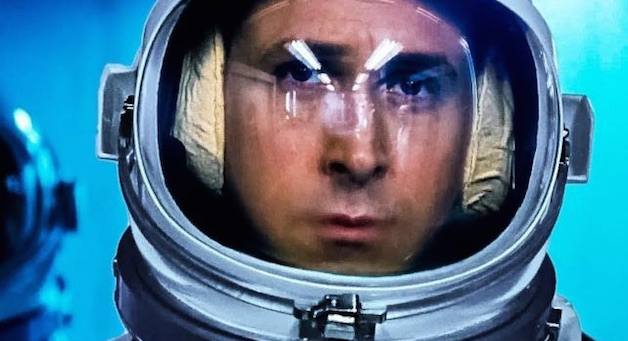Forget the controversy, ‘First Man’ honors American hero

“One small step for man, one giant leap for mankind.” So said Neil Armstrong when he first set foot on the moon—perhaps one of the most famous quotes in American history. It forever put him in the annals as a national hero.
But as immortal as those words might’ve been, they sold the step short. That one small step came after eight long years of steps and more steps, missteps and disastrous falls. People sacrificed a great deal for Armstrong to take that step—including their very lives. Eight years of trial and tragedy, of life and breath, of math and science and just plain guts, went into that step. And when Armstrong took it, he carried the work of thousands of people, and the hopes and dreams of millions more, on his back.
The honor of being the first man on the moon wasn’t something Neil sought: He was a quiet man, as humble and as retiring as a national hero can possibly be, and America loved him for it.
They sacrificed
He sacrificed a lot to be there, too. But inside the Armstrong home, Neil’s dedication sometimes took on a darker hue. To his wife, Janet, sometimes it was hard

to see whether Neil was trying to get to the moon … or away from home. Escape the responsibilities of being a husband, a father to their two sons, Rick and Mark, or to run away from the crushing grief he felt over the death of his daughter, Karen.
She wasn’t even three years old.
“One small step,” Neil said. But his own journey to the moon was filled with a million steps, skips and stumbles. Sometimes, he seemed to crawl. But eventually, those steps took him the 239,000 miles to the moon and back again. And through so many of those steps—too many, perhaps—he preferred to walk alone.
It goes without saying that Neil Armstrong is on a short list of true American heroes. After Washington and Lincoln, would Armstrong be far behind?
Armstrong the man
The Neil we meet in First Man is indeed remarkable, in part because of his un-remarkableness. Oh, he’s incredibly brave and smart and dedicated: The film makes no secret of what made him a suitable astronaut. But we learn here that he is one of many remarkable, brave young men who risk and sometimes even sacrifice their lives to pursue their unusual vocation. If anything, Armstrong’s humility allows him to blend in. He isn’t the first choice to command the Apollo 11 spacecraft. But when he’s finally chosen, he accepts the honor not with unseemly bravado or false modesty, but a quiet, grateful confidence.
But while it takes Neil years to, as CBS journalist Walter Cronkite said, “slip the surly bonds of earth,” the astronaut’s mind is rarely home. We understand he loves his family, but it’s often up to his wife, Janet, to keep it together—shepherding her sometimes unruly sons and smoothing over her husband’s brusque, sometimes door-slamming remove. She’s just as heroic in her own way as Neil is in his—and a far more charming, relatable presence on screen.
Dangerous work
First Man is exceedingly effective in conveying how dangerous Armstrong’s work was. Whether he’s sitting in a jet or rocketship, we get a sense of the raw power involved: He shakes violently inside the cockpit, and the window he looks out onto the wider world is often filled with fire or smoke or plain visual dissonance—the image vibrating so violently that whatever’s outside is nearly indistinguishable. I felt more G-forces in First Man than I have on any roller coaster. And sometimes, all that raw power we see and feel can go tragically awry.
Gus Grissom, Roger Chaffee and Ed White—perhaps Neil’s best friend in the program—are killed during a 1967 training mission. Some faulty wiring sparks a fire in the command capsule that, when mixed with the enriched oxygen in the hold, ignites in a massive fireball. We see the fire sweep over the buckled-in astronauts (their bodies and faces obscured by their spacesuits). Later, we learn that all three died in the explosion, and that their bodies were left in the capsule for hours during the investigation.
The flag controversy
OK, let’s get this out of the way first: It’s true, we don’t see Armstrong and Buzz Aldrin actually plant the American flag on the moon.
Weeks before the film came out, First Man engendered (or engineered?) a bit of controversy over that omission from some political sectors, with one senator calling it “total lunacy.”
When people see how Armstrong spends his time on the moon—the most emotional scene in the movie—perhaps some of the critics will understand why director Damien Chazelle made that choice.
We see the flag they planted on the moon, though. The flag is also seen elsewhere, and frequently. You hear to lots of talk about the American-Soviet rivalry in space (a critical component of the story, in fact). And following a [spoiler alert] successful moon landing, we see and hear an apparently real interview of a French woman telling a reporter that she “always trusted America.”
So, if you’re looking for a film that will kindle a sense of nationalistic pride in you and yours, First Man feels more like a match than a bucket of cold water.
This isn’t an old-fashioned John Wayne or Gary Cooper flick, filled with un-alloyed heroism. Rather, it is an earnest appraisal of what it takes to be an honest-to-goodness-hero in a real life. This movie takes a complicated look at a complex individual. And while never diminishing his role as a man who inspires, it brings him down to Earth.
Conclusion
The film has some content concerns as well, most notably its language and the loss of life we see. The latter is historically accurate, of course, and the former doesn’t feel out of place, but they are there—and for some, they could be as much of a deal-killer as, apparently, the omitted American flag-planting.
But for others, First Man puts flesh on a marbled hero, complexities, flaws and all.
–By Paul Assay, PluggedIn







